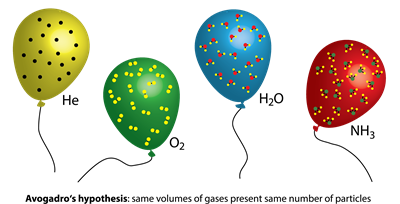PDF chapter test TRY NOW
In 1811, Avogadro proposed a hypothesis based on the number of molecules present in equal amounts of gases under different conditions.
Avogadro’s law states that “equal volumes of all gases under similar conditions of temperature and pressure contain the equal number of molecules”.
As a result, the volume of any gas must be proportional to the number of molecules present in it. If 'V' is the volume and 'n' is the number of molecules in a gas, then Avogadro law is written as follows:
For example, the number of molecules in one litre (1 dm^3) of hydrogen is the same as in one litre (1 dm^3) of oxygen.

Explanation:
Consider the reaction of the formation of hydrogen chloride.
H_2(g)+Cl_2(g)→ 2HCl(g)
1 vol + 1 vol → 2 vol
According to Avogadro’s law, 1 volume of any gas is occupied by “n” number of molecules.
n molecules + n molecules→2n molecules
If n=1, then
1 molecule+1 molecule→2 molecules
1⁄2 molecule +1⁄2 molecule→1 molecule
1 molecule of hydrogen chloride gas is made up of 1⁄2 molecule of hydrogen and 1⁄2 molecule of chlorine. Therefore, the molecules can be subdivided. This law is in accordance with Dalton’s atomic theory.
Applications of Avogadro's law:
- It describes the law of Gay-Lussac.
- It helps in identifying the atomicity of gases.
- Avogadro's law can be used to find the molecular formula of gases.
- The relation between molecular mass and vapour density is determined by it.
- It helps to calculate the gram molar volume of all gases (i.e., 22.4 litre at STP).
